Abstract
To cause disease, influenza virus must possess several genetically determined abilities that mediate stages in pathogenesis. The virulent mouse-adapted variant A/FM/1/47-MA (FM-MA), derived from the avirulent A/FM/1/47 (FM) strain, had acquired mutations in genes that control virulence. The purpose of this study was to identify those genes that had mutated to result in increased virulence and to obtain viruses that differed in virulence because of differences in individual genome segments. The genes that had mutated to increase virulence were initially identified by genetic analysis of reassortants obtained by crossing FM-MA with the avirulent strain A/HK/1/68 (HK). FM-MA genome segments 4, 5, 7, and 8 were significantly associated with virulence, as determined by using the Wilcoxon ranked sum analysis. The role of FM-MA segments 4, 7, and 8 was confirmed by reintroduction of these genes into the parental strain, which also provided virus strains that differed in virulence because of mutations in individual genome segments. Segments 4, 7, and 8 were responsible for a 10(3.6)-fold increase in virulence that was proportioned 10(2.2)-, 10(0.7)-, and 10(0.8)-fold, respectively. The role of segment 5 could not be confirmed on transfer back into the parental strain because of reversion during preparation of such reassortants. The incidence of reversion was shown to be significantly associated with culturing of FM-MA in chicken embryo cells but was not associated with growth in MDCK cells. The genetic analysis of FM-MA suggests that adaptation to increased virulence is an incremental process that involves the acquisition of mutations in multiple genes, each of which plays an individual role in pathogenesis. The structural and functional properties of segments 4, 7, and 8 that control the virulence of FM-MA can now be determined by using viruses that differ in virulence because of mutations in these individual genome segments.
Full text
PDF
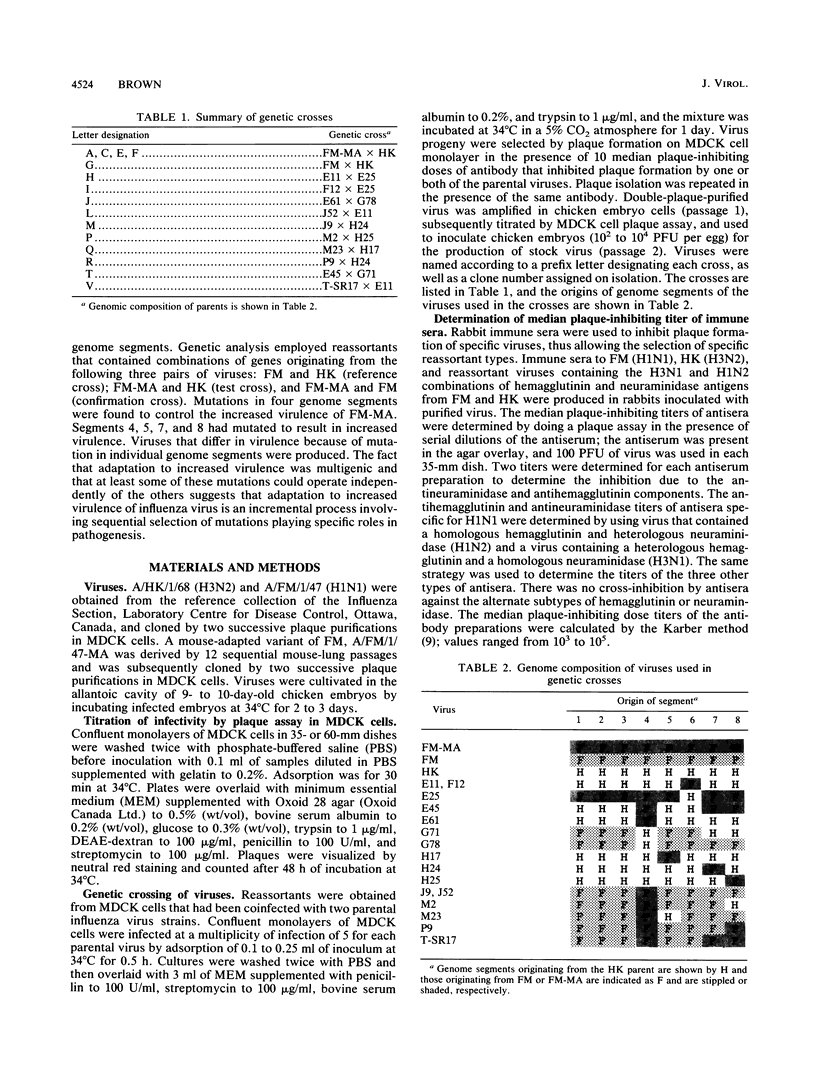
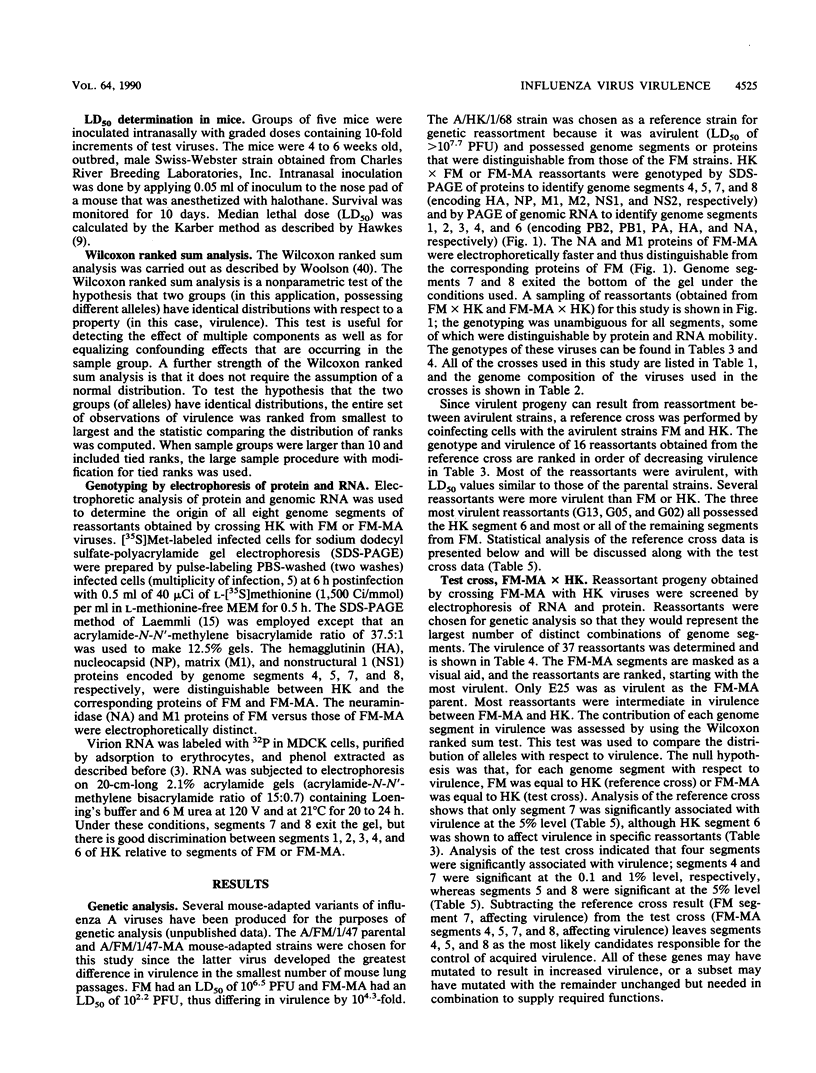

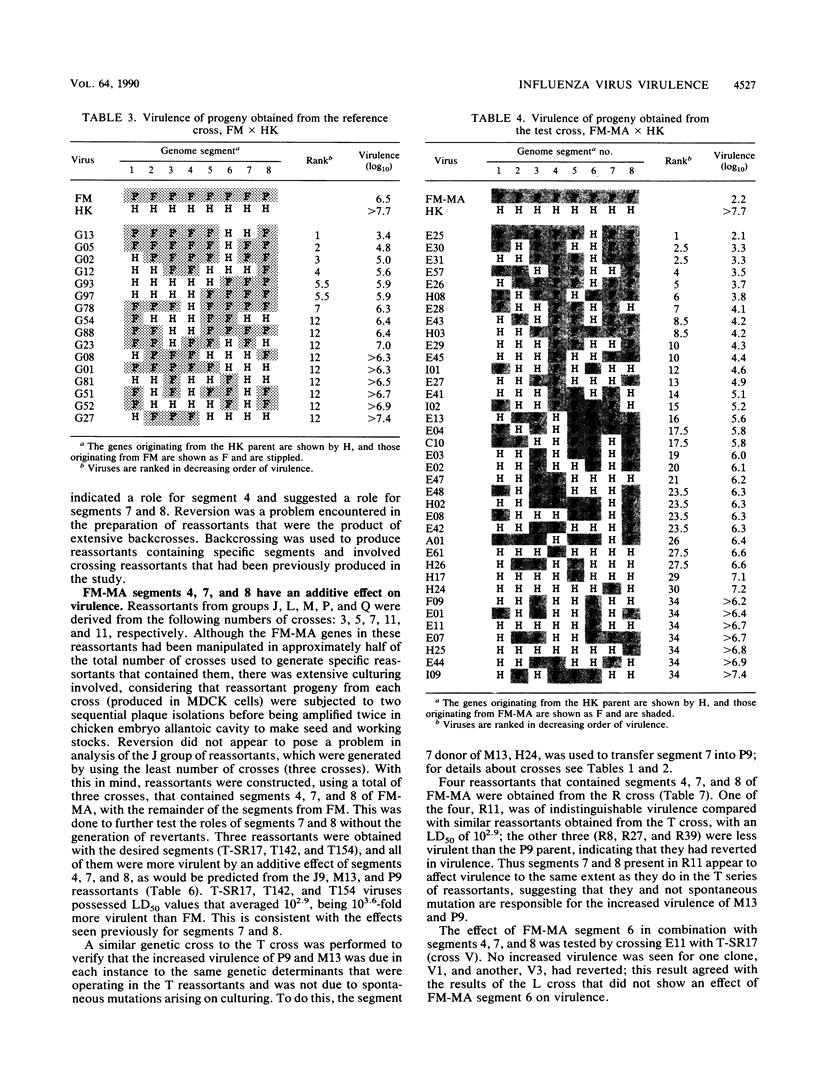


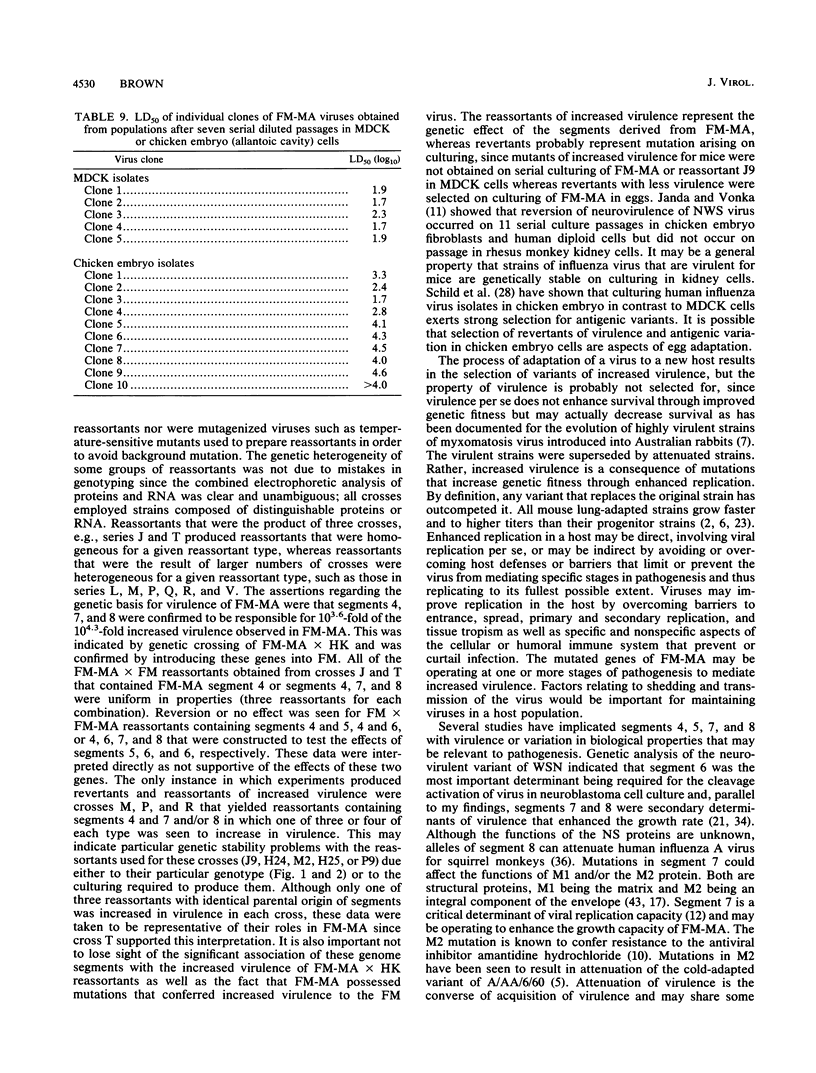

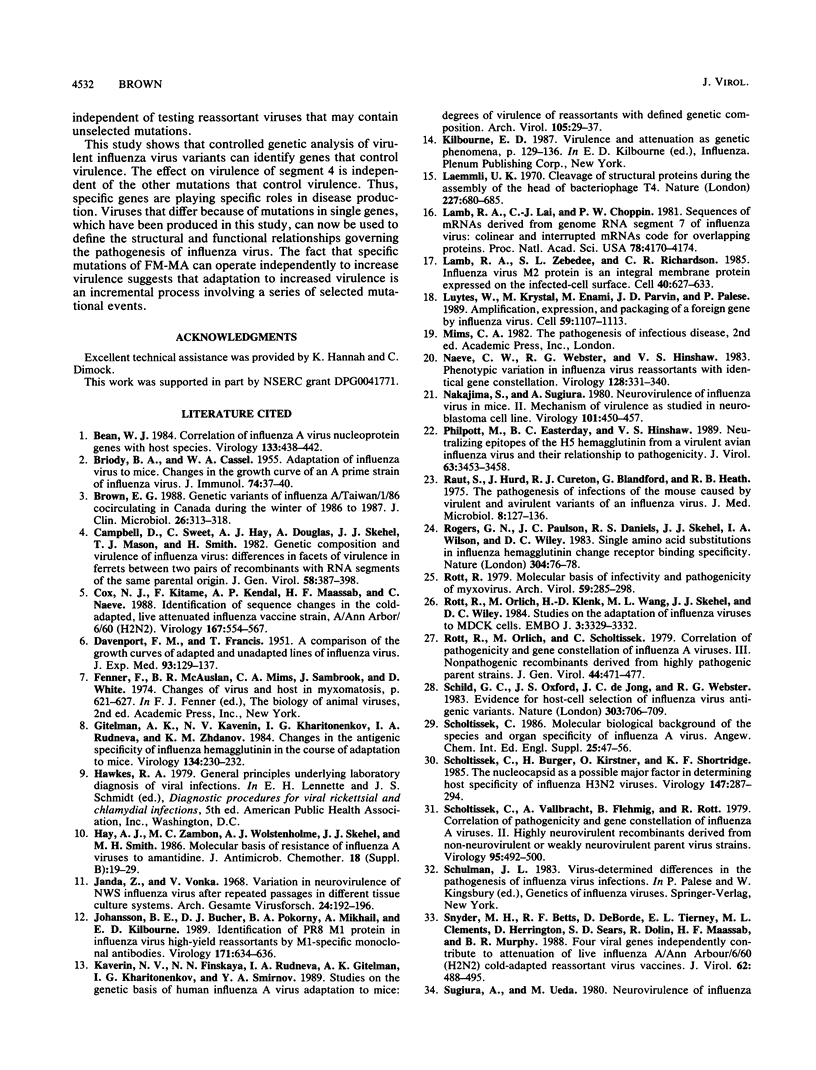

Images in this article
Selected References
These references are in PubMed. This may not be the complete list of references from this article.
- BRIODY B. A., CASSEL W. A. Adaptation of influenza virus to mice. II. Changes in the growth curve of an A prime strain of influenza virus. J Immunol. 1955 Jan;74(1):37–40. [PubMed] [Google Scholar]
- Bean W. J. Correlation of influenza A virus nucleoprotein genes with host species. Virology. 1984 Mar;133(2):438–442. doi: 10.1016/0042-6822(84)90410-0. [DOI] [PubMed] [Google Scholar]
- Brown E. G. Genetic variants of influenza A/Taiwan/1/86 cocirculating in Canada during the winter of 1986 to 1987. J Clin Microbiol. 1988 Feb;26(2):313–318. doi: 10.1128/jcm.26.2.313-318.1988. [DOI] [PMC free article] [PubMed] [Google Scholar]
- Campbell D., Sweet C., Hay A. J., Douglas A., Skehel J. J., Mason T. J., Smith H. Genetic composition and virulence of influenza virus: differences in facets of virulence in ferrets between two pairs of recombinants with RNA segments of the same parental origin. J Gen Virol. 1982 Feb;58(Pt 2):387–398. doi: 10.1099/0022-1317-58-2-387. [DOI] [PubMed] [Google Scholar]
- Cox N. J., Kitame F., Kendal A. P., Maassab H. F., Naeve C. Identification of sequence changes in the cold-adapted, live attenuated influenza vaccine strain, A/Ann Arbor/6/60 (H2N2). Virology. 1988 Dec;167(2):554–567. [PubMed] [Google Scholar]
- DAVENPORT F. M., FRANCIS T., Jr A comparison of the growth curves of adapted and unadapted lines of influenza virus. J Exp Med. 1951 Feb;93(2):129–137. doi: 10.1084/jem.93.2.129. [DOI] [PMC free article] [PubMed] [Google Scholar]
- Gitelman A. K., Kaverin N. V., Kharitonenkov I. G., Rudneva I. A., Zhdanov V. M. Changes in the antigenic specificity of influenza hemagglutinin in the course of adaptation to mice. Virology. 1984 Apr 15;134(1):230–232. doi: 10.1016/0042-6822(84)90288-5. [DOI] [PubMed] [Google Scholar]
- Hay A. J., Zambon M. C., Wolstenholme A. J., Skehel J. J., Smith M. H. Molecular basis of resistance of influenza A viruses to amantadine. J Antimicrob Chemother. 1986 Oct;18 (Suppl B):19–29. doi: 10.1093/jac/18.supplement_b.19. [DOI] [PubMed] [Google Scholar]
- Janda Z., Vonka V. Variation in neurovirulence of NWS influenza virus after repeated passages in different tissue culture systems. I. Derivation and neurotropic activity of NWS virus lines. Arch Gesamte Virusforsch. 1968;24(3):192–196. doi: 10.1007/BF01241291. [DOI] [PubMed] [Google Scholar]
- Johansson B. E., Bucher D. J., Pokorny B. A., Mikhail A., Kilbourne E. D. Identification of PR8 M1 protein in influenza virus high-yield reassortants by M1-specific monoclonal antibodies. Virology. 1989 Aug;171(2):634–636. doi: 10.1016/0042-6822(89)90638-7. [DOI] [PubMed] [Google Scholar]
- Kaverin N. V., Finskaya N. N., Rudneva I. A., Gitelman A. K., Kharitonenkov I. G., Smirnov Y. A. Studies on the genetic basis of human influenza A virus adaptation to mice: degrees of virulence of reassortants with defined genetic content. Arch Virol. 1989;105(1-2):29–37. doi: 10.1007/BF01311114. [DOI] [PubMed] [Google Scholar]
- Laemmli U. K. Cleavage of structural proteins during the assembly of the head of bacteriophage T4. Nature. 1970 Aug 15;227(5259):680–685. doi: 10.1038/227680a0. [DOI] [PubMed] [Google Scholar]
- Lamb R. A., Lai C. J., Choppin P. W. Sequences of mRNAs derived from genome RNA segment 7 of influenza virus: colinear and interrupted mRNAs code for overlapping proteins. Proc Natl Acad Sci U S A. 1981 Jul;78(7):4170–4174. doi: 10.1073/pnas.78.7.4170. [DOI] [PMC free article] [PubMed] [Google Scholar]
- Lamb R. A., Zebedee S. L., Richardson C. D. Influenza virus M2 protein is an integral membrane protein expressed on the infected-cell surface. Cell. 1985 Mar;40(3):627–633. doi: 10.1016/0092-8674(85)90211-9. [DOI] [PubMed] [Google Scholar]
- Luytjes W., Krystal M., Enami M., Parvin J. D., Palese P. Amplification, expression, and packaging of foreign gene by influenza virus. Cell. 1989 Dec 22;59(6):1107–1113. doi: 10.1016/0092-8674(89)90766-6. [DOI] [PubMed] [Google Scholar]
- Naeve C. W., Webster R. G., Hinshaw V. S. Phenotypic variation in influenza virus reassortants with identical gene constellations. Virology. 1983 Jul 30;128(2):331–340. doi: 10.1016/0042-6822(83)90260-x. [DOI] [PubMed] [Google Scholar]
- Nakajima S., Sugiura A. Neurovirulence of influenza virus in mice. II. Mechanism of virulence as studied in a neuroblastoma cell line. Virology. 1980 Mar;101(2):450–457. doi: 10.1016/0042-6822(80)90458-4. [DOI] [PubMed] [Google Scholar]
- Philpott M., Easterday B. C., Hinshaw V. S. Neutralizing epitopes of the H5 hemagglutinin from a virulent avian influenza virus and their relationship to pathogenicity. J Virol. 1989 Aug;63(8):3453–3458. doi: 10.1128/jvi.63.8.3453-3458.1989. [DOI] [PMC free article] [PubMed] [Google Scholar]
- Raut S., Hurd J., Blandford G., Heath R. B., Cureton R. J. The pathogenesis of infections of the mouse caused by virulent and avirulent variants of an influenza virus. J Med Microbiol. 1975 Feb;8(1):127–136. doi: 10.1099/00222615-8-1-127. [DOI] [PubMed] [Google Scholar]
- Rogers G. N., Paulson J. C., Daniels R. S., Skehel J. J., Wilson I. A., Wiley D. C. Single amino acid substitutions in influenza haemagglutinin change receptor binding specificity. Nature. 1983 Jul 7;304(5921):76–78. doi: 10.1038/304076a0. [DOI] [PubMed] [Google Scholar]
- Rott R. Molecular basis of infectivity and pathogenicity of myxovirus. Brief review. Arch Virol. 1979;59(4):285–298. doi: 10.1007/BF01317469. [DOI] [PubMed] [Google Scholar]
- Rott R., Orlich M., Klenk H. D., Wang M. L., Skehel J. J., Wiley D. C. Studies on the adaptation of influenza viruses to MDCK cells. EMBO J. 1984 Dec 20;3(13):3329–3332. doi: 10.1002/j.1460-2075.1984.tb02299.x. [DOI] [PMC free article] [PubMed] [Google Scholar]
- Rott R., Orlich M., Scholtissek C. Correlation of pathogenicity and gene constellation of influenza A viruses. III. Non-pathogenic recombinants derived from highly pathogenic parent strains. J Gen Virol. 1979 Aug;44(2):471–477. doi: 10.1099/0022-1317-44-2-471. [DOI] [PubMed] [Google Scholar]
- Schild G. C., Oxford J. S., de Jong J. C., Webster R. G. Evidence for host-cell selection of influenza virus antigenic variants. Nature. 1983 Jun 23;303(5919):706–709. doi: 10.1038/303706a0. [DOI] [PubMed] [Google Scholar]
- Scholtissek C., Bürger H., Kistner O., Shortridge K. F. The nucleoprotein as a possible major factor in determining host specificity of influenza H3N2 viruses. Virology. 1985 Dec;147(2):287–294. doi: 10.1016/0042-6822(85)90131-x. [DOI] [PubMed] [Google Scholar]
- Scholtissek C., Vallbracht A., Flehmig B., Rott R. Correlation of pathogenicity and gene constellation of influenza A viruses. II. Highly neurovirulent recombinants derived from non-neurovirulent or weakly neurovirulent parent virus strains. Virology. 1979 Jun;95(2):492–500. doi: 10.1016/0042-6822(79)90503-8. [DOI] [PubMed] [Google Scholar]
- Snyder M. H., Betts R. F., DeBorde D., Tierney E. L., Clements M. L., Herrington D., Sears S. D., Dolin R., Maassab H. F., Murphy B. R. Four viral genes independently contribute to attenuation of live influenza A/Ann Arbor/6/60 (H2N2) cold-adapted reassortant virus vaccines. J Virol. 1988 Feb;62(2):488–495. doi: 10.1128/jvi.62.2.488-495.1988. [DOI] [PMC free article] [PubMed] [Google Scholar]
- Sugiura A., Ueda M. Neurovirulence of influenza virus in mice. I. Neurovirulence of recombinants between virulent and avirulent virus strains. Virology. 1980 Mar;101(2):440–449. doi: 10.1016/0042-6822(80)90457-2. [DOI] [PubMed] [Google Scholar]
- Sweet C., Smith H. Pathogenicity of influenza virus. Microbiol Rev. 1980 Jun;44(2):303–330. doi: 10.1128/mr.44.2.303-330.1980. [DOI] [PMC free article] [PubMed] [Google Scholar]
- Treanor J. J., Snyder M. H., London W. T., Murphy B. R. The B allele of the NS gene of avian influenza viruses, but not the A allele, attenuates a human influenza A virus for squirrel monkeys. Virology. 1989 Jul;171(1):1–9. doi: 10.1016/0042-6822(89)90504-7. [DOI] [PubMed] [Google Scholar]
- Webster R. G., Kawaoka Y., Bean W. J., Jr Molecular changes in A/Chicken/Pennsylvania/83 (H5N2) influenza virus associated with acquisition of virulence. Virology. 1986 Mar;149(2):165–173. doi: 10.1016/0042-6822(86)90118-2. [DOI] [PubMed] [Google Scholar]
- Wiley D. C., Skehel J. J. The structure and function of the hemagglutinin membrane glycoprotein of influenza virus. Annu Rev Biochem. 1987;56:365–394. doi: 10.1146/annurev.bi.56.070187.002053. [DOI] [PubMed] [Google Scholar]
- Ye Z. P., Pal R., Fox J. W., Wagner R. R. Functional and antigenic domains of the matrix (M1) protein of influenza A virus. J Virol. 1987 Feb;61(2):239–246. doi: 10.1128/jvi.61.2.239-246.1987. [DOI] [PMC free article] [PubMed] [Google Scholar]
- Young J. F., Desselberger U., Palese P. Evolution of human influenza A viruses in nature: sequential mutations in the genomes of new H1N1. Cell. 1979 Sep;18(1):73–83. doi: 10.1016/0092-8674(79)90355-6. [DOI] [PubMed] [Google Scholar]
- Zebedee S. L., Lamb R. A. Influenza A virus M2 protein: monoclonal antibody restriction of virus growth and detection of M2 in virions. J Virol. 1988 Aug;62(8):2762–2772. doi: 10.1128/jvi.62.8.2762-2772.1988. [DOI] [PMC free article] [PubMed] [Google Scholar]





